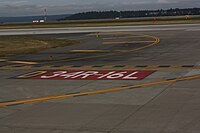Tag:aeroway=holding_position
 |
| Description |
|---|
| A point behind which aircraft are considered clear of a crossing way |
| Group: aeroways |
| Used on these elements |
| Status: de facto |
| Tools for this tag |
A holding position is a location on the airport surface, marked by a painted surface markings and signage, which an aircraft may be instructed either to stop at or clear (as when exiting a runway). There are three types of holding position markings: runway, ILS critical area, and intermediate (or taxiway/taxiway). Though the terminology varies slightly, both the FAA and ICAO use all three types of holding position markings, and the symbology for each is the same.
Types of Holding Positions
Runway holding positions identify the runway safety area. At controlled airports, these markings - commonly called hold lines - indicate where an aircraft is to stop if the aircraft does not have permission to enter the runway. When exiting a runway, an aircraft is not considered clear of that runway until all parts of the aircraft have crossed the holding position. The runway holding position marking is painted across the runway or taxiway and consists of two solid lines on the taxiway side and two dashed lines on the side of the runway safety area.
There are also LAHSO holding positions which are marked on runways themselves, which indicate the point at which an aircraft should Land And Hold Short (generally before proceeding to cross another runway, to allow multiple aircraft to land rapidly.) These positions look and work much the same as regular hold positions: the solid lines are on the approach side, and the dashed lines are on the side to not be crossed until permission is given, but will be on a runway rather than taxiway.
ILS critical area holding positions are used to protect Instrument Landing System (ILS) signals. When necessary, Air Traffic Control will instruct an aircraft to hold short of the runway at the marking - or, when existing the runway, clear the ILS marking - to ensure the aircraft does not block or interfere with the ILS signals. The ILS surface marking consists of two lines painted across the taxiway, in between which are pairs of lines painted along the taxiway.
Intermediate, or taxiway/taxiway holding positions are located at the intersection of two taxiways. Intermediate holding positions are used to ensure adequate clearance from aircraft crossing on an intersecting taxiway. The surface marking is a single yellow broken line painted across the taxiway.
Movement/Non-Movement Area boundaries indicate locations in an airport where aircraft and vehicles go from the "non-movement area" (uncontrolled taxiways and ramp areas) on the solid-yellow-line side to the "movement area" (Air Traffic Control Tower controlled taxiways and runways) on the dashed-yellow-bar side. Aircraft and vehicles must hold short of Non-Movement Area boundaries on taxiways and obtain ATC permission before crossing from the non-movement area into the movement area.
How to map
Holding positions may be marked either with a node at the intersection of the painted surface marking at the taxiway centerline, or with a way drawn along the painted holding position surface marking. Where the holding position marking is not straight, is at the intersection of multiple taxiways, or is not orthogonal to the taxiway, a way is preferred to a node.
Note that there is a new (31-08-2022) proposal for a separate tag to tag the actual holding position line on the tarmac, so as to prevent edit wars surrounding holding positions tagged as either nodes or ways. You can now tag both as separate objects. See the rational for this on the proposal page:
Proposal:Aeroway=holding position line
Each holding position marking is tagged with aeroway=holding_position. The type of holding position marking can optionally be included with the following tags:
holding_position:type=runway– For runway holding positions (generally on taxiways)holding_position:type=LAHSO– For LAHSO runway holding positions (generally on runways and only used for LAHSO)holding_position:type=ILS– For ILS critical holding positionsholding_position:type=intermediate– For intermediate holding positions at taxiway/taxiway intersectionsholding_position:type=movement– For Movement/Non-Movement Area boundary holding points along a taxiway
Note
Not the same as a ![]() Holding pattern (a maneuver designed to delay an aircraft already in flight while keeping it within a specified airspace).
Holding pattern (a maneuver designed to delay an aircraft already in flight while keeping it within a specified airspace).
See also
![[W]](https://upload.wikimedia.org/wikipedia/commons/thumb/0/00/Tango_style_Wikipedia_Icon_no_shadow.svg/16px-Tango_style_Wikipedia_Icon_no_shadow.svg.png) Taxiway – with information on holding positions and other markings.
Taxiway – with information on holding positions and other markings.- ICAO Annex 14 volume 1 – Aerodromes § 5.2.10 and 5.2.11 where can be found detailed documentation.
- "Airport markings" presentation by ICAO & FAA


